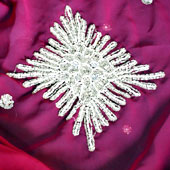Zardozi Embroidery of Allahabad
Zardozi is the work of a skilled hand of the artisans and their creative designs. The process of Zardozi is divided into following steps:
• Tracing
• Setting of Adda
• Embroidery
• Finishing
Tracing:
The process of embroidery starts with tracing the motifs on the plain cloth. The motifs are first sketched on a tracing paper or butter paper and small holes are made on the outlines of the designs using a needle. Thereafter the cloth is placed on a flat surface and the tracing sheet is placed on the position the motif is required. Artisans either use a mixture of neel and kerosene or chalk power and kerosene. A cloth dipped in either of the two solutions is rubbed on the khaakha (tracing sheet) so that the solution seeps through the holes and reaches the cloth. Thus the designs get traced on the cloth. This process is called as Chapaai and is done by either men or women who are referred as Chapai wale/ wali.
Setting the Adda:
It is wooden frame on which the cloth to be embroidered is stretched tightly making it suitable for working. This frame has adjustable knockdown bars resting on four stools or post at four corners. The frames can be adjusted according to the width of the cloth. These frames are large and mainly made up of sheesham as it is strong, but sometimes bamboo is also used as a substitute. One frame can accommodate 4-6 artisans sitting on both the sides. The height of the frame is 1.5-2 feet above the ground. The artisans sit either on floor or cushions. If the design is small, then a smaller metal frame can also be used instead of the wooden planks.
Embroidery:
The cloth to be embroidered is first stitched to the Patti (thick cloth) attached to the adda. Thereafter with the help of aari (needle) the embroidery is initiated. The hook at the tip of the aari enables the artisan to pass the threads both above and below the fabric. The needle works same as a sewing machine. This method of embroidery is highly time consuming and therefore expensive too. Depending on the intricacy it may take a day or a month to complete a design.
Finishing:
Once the embroidery is done extra threads are cut and the cloth is taken out from the adda. It then goes for washing and finally gets ironed and packed and then sold in the market.











